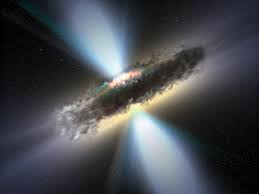
There are a multitude of black holes portrayals in science fiction. Many examples include:Interstellar, Event Horizon, Star Trek, Battlestar Galactica, Treasure Island, Superman: The Animated Series, Transformers.
The nearest black hole is 1,600 light years away. That is about 16 quadrillion kilometers for Earth.
You Can’t Directly See a Black Hole.
Black holes emit x-ray radiation and get smaller and smaller until they disappear, or “evaporate”.
Our Milky Way Probably Has a Black Hole.
Most black holes are formed from the death of large stars (larger than the sun) that run out of fuel and cannot sustain its nuclear reaction. The star loses the force pushing itself outward and is overcome by the force of its own gravity pulling inward. Eventually, the star has so much gravity and is so compacted that it “eats itself” until there is nothing left but a hole in the “fabric” of space-time, created by the gravity left over from the star.
Dying Stars Lead to Stellar Black Holes.
The gravity around the “hole” of a black hole is so strong that NOTHING can make its way back out after a critical distance.
Primordial Black holes – These are the smallest of black holes and range from an atom’s size to a mountain’s mass.
The critical distance at which nothing can escape is called the Event Horizon.
Stellar Black Holes – These are the most common of black holes and they can be up to 20 times more massive than the Sun. There are also a variety of these all over the Milky Way.
Even light cannot travel back out of a black hole after crossing the Event Horizon.
Supermassive Black Holes – These are the largest of black holes, being more than 1 million times more massive than the Sun.
Even before crossing the event horizon, though possible to travel away from the black hole, it is not easy. Even light has a hard time getting out, so light being emitted from something almost at the Event Horizon but not yet inside the threshold takes a much longer time to escape and be seen by someone then it would in normal space going at 186,000 miles per second.
The First Black Hole Wasn’t Discovered Until X-Ray Astronomy was Used.
The Singularity is the true point of destruction, the actual hole part of the black hole, although any object, especially a person, would be long dead before they reached the Singularity.
The Closest Black Hole is Probably Not 1,600 Light-Years Away.
Some black holes are spinning and have several event horizons called the “Ergosphere”, “Outer Event Horizon”, and “Inner Event Horizon”.
Black holes are safe to observe from a lengthy distance, but not if you get too close, which also means that it’s unlikely for a black hole to consume an entire universe.









